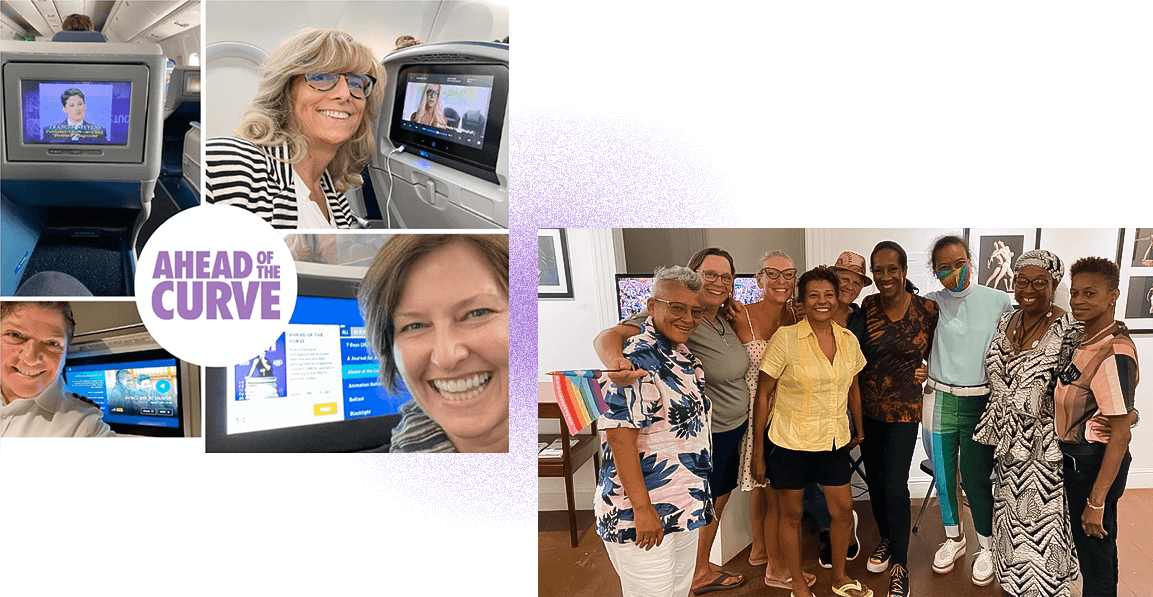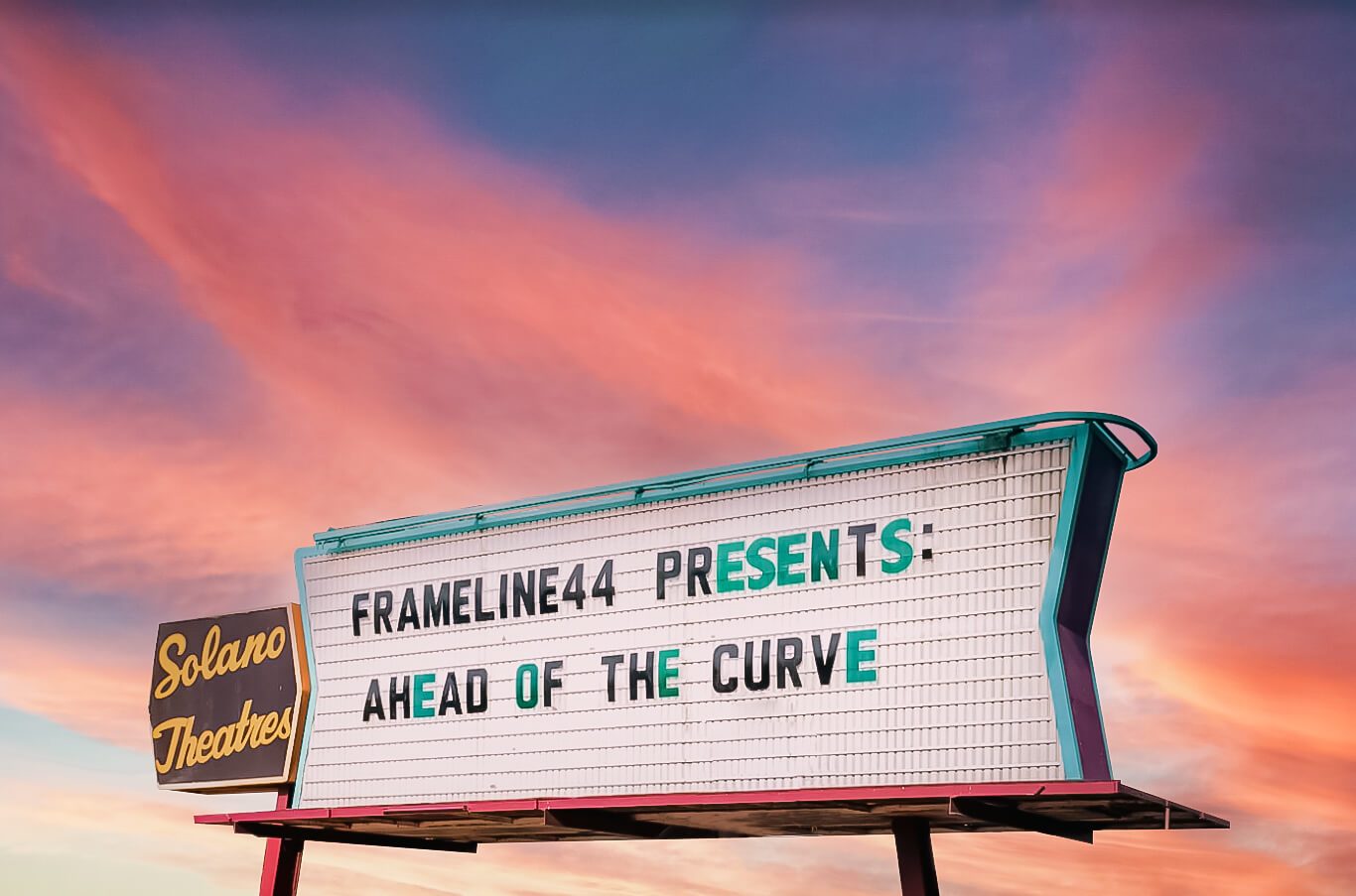It could be the most important documentary about lesbian visibility ever made, achieving the greatest cultural visibility through a film that’s all about being seen as an LGBTQ+ woman in the full spectrum of what that means. Ever since its release in June 2020, Ahead of the Curve by Frankly Speaking Films achieved its own visibility feat: It screened in over 75 national and international film festivals as well as on multiple airlines, reaching a huge range of audiences, demographics, and identities!
The film brought the story of Franco Stevens, her creation of the landmark lesbian newsstand magazine Curve, and how that work connects with activists today to an entirely new audience. In this way it not only struck a blow for lesbian visibility — it continues to do that work every time it is screened. If you have not yet seen the film there are a variety of ways you can watch it here.
With on-screen appearances by Melissa Etheridge, Lea DeLaria and more, and music composed by Meshell Ndegeocello, Ahead of the Curve is both familiar and revelatory. Put it this way: As a former Editor-in-Chief of Curve magazine, even though I am in the film briefly and lived through much of the history and issues covered in the film, I was also surprised, delighted, entertained, and moved to tears by the story of Franco and what she achieved. And many others feel this way too. Ahead of the Curve has won the audience award four times at film festivals and received rave reviews from The Boston Globe, The Guardian, The L.A. Times, and The Hollywood Reporter who called it “accomplished, resonant, and deeply moving.”
Two and a half years since its release and distribution — during one of the worst times in history for gathering people together — Ahead of the Curve continues to connect and advocate for acceptance of lesbians, queer women, and nonbinary people everywhere. I sat down with co-directors Jen Rainin and Rivkah Beth Medow and asked them to comment on the film’s journey in the wider world.
Merryn Johns: How does it feel looking back at the arc of Ahead of the Curve these past couple of years?
Jen Rainin: It’s been such an amazing ride! It’s really gratifying to see how it’s landed in the world. Every review was so warm and it just felt amazing. But watching this film go out into the world — particularly once we got airline distribution — has been incredibly heartening. We have heard from so many people around the world. Franco gets recognized in the street…total strangers who had seen the film and were so moved. So there’s just been an outpouring of sentiment from people who see the film saying, ‘My God, I remember that,’ or ‘That was so important to me.’ More than a handful of times we’ve heard ‘That magazine saved my life,’ and that’s been incredible. For Franco, it’s a huge deal. This was her life’s work. And it felt like it was sort of disappearing…
Rivkah Beth Medow: No one had collected her story. The magazine wasn’t online in the way that a lot of magazines are now. And no one had taken the archive and really organized it, reflected it back to our culture and tied it to so many of the conversations that we’re having today.
Effectively, Ahead of the Curve is continuing the work of the magazine, and what Franco set out to do. Now the film seems to have found a huge audience, which is wonderful for lesbian visibility and acceptance.
Rivkah Beth Medow: Jen and I were actually really surprised to have two audiences. We always knew that the Curve readership would be really supportive, and we thought that would be our main audience. But what ended up happening is that there was another audience that responded powerfully; younger women, women under 25, who were so hungry to hear their history and to understand from where so much LGBTQ+ women’s culture had emanated. The nineties were such a crucial decade for amassing collective power and agency, really understanding that we had a voice. Since the broad release in 2021 where so many more people have been able to see it, our social media channels have just lit up.[https://www.facebook.com/CurveMagMovie/] Once we got airline distribution, Jen and I would get photographs almost every day from people saying, ‘Look, it’s on my plane!’
Pardon the pun, but as filmmakers was that a high point?
Jen Rainin: I mean, it was always sort of a fantasy. There have been a few milestones like that for us. I think one of the big ones was seeing Ahead of the Curve up on a marquee in New York at IFC Center. The first time we saw it, we lost our minds. It was so thrilling. And every time we see it on a marquee, it’s a huge deal. But then to see it on Apple and on Amazon Prime Video and Starz… That was so validating. It feels so good to see. And then you’re right, it was sort of the cherry on top to get it onto airlines where you know that there are audiences who never would look for it, who never would come across it otherwise. But they’re sitting in their flying box for hours and scrolling through. And it turns out a lot of people like to watch documentaries.

Rivkah Beth Medow: Another thing to note, which tracks back to Franco’s genius, was emulating her idea to put Curve right next to all the other women’s magazines. Same high level of execution. Same caliber. Right? Being programmed on airlines telegraphs ‘We’re there, too. We deserve a spot. We deserve a place alongside all of the other cultural offerings.’
Can you make a connection between what you’ve achieved with Ahead of the Curve and what The Curve Foundation aims to achieve?
Jen Rainin: Franco and I founded The Curve Foundation. We started it, but we’re not running it. But in a way, it’s sort of like the same structure as the magazine where she was the publisher, but she brought in an editor to execute it. Like the film, the foundation is continuing her vision and her mission to lift up our stories and our voices and make sure that the community continues to grow and build and to literally feel that there’s a foundation beneath our feet.
Rivkah Beth Medow: I think that The Foundation really supporting and seeding queer women’s stories is an essential, beautifully strategic move to ensure that we continue having a voice in the culture. So I see that as foundational. It secures and ensures that the archives of the magazine are accessible to generations to come as resources so that journalists can continue to tell our stories. There’s a lot of creativity happening in The Foundation now. I think it’s being built to last.
